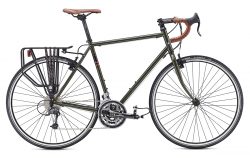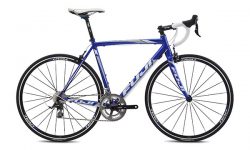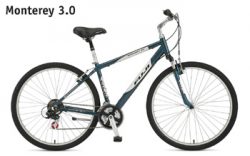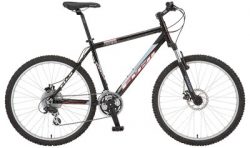We no longer stock Fuji Bicycles
Beginning in 1899 Fuji has recorded an impressive number of technological firsts. In 2000, they recorded firsts again with the Fuji Team, the bike the Mercury Cycling Team rode to more US National Cup wins than any other team in the past three seasons. Fuji continues its tradition of innovation and value that is hard to beat.
History of Fuji Bicycles
Just before the turn of the century in 1899, Japan’s Nichibei Fuji was born. Since the first Fuji bike was built, Fuji was destined to become a leader in the bicycle industry. When the first bikes rolled off the line, Fuji engineers recognized the need for designs that would perform at a higher level. By the roaring twenties, Fuji was well on its way and was Japan’s most popular bike, dominating not just the marketplace, but also winning races in the increasingly popular cycling competitions being held around Japan.
Fuji engineers began researching and developing bicycles for world-class racing, not only to win, but also to use the competitive environment as a laboratory for advanced bicycle technology, discovering faster, lighter and more durable designs. In the 30’s, Fuji established the first national stage race between Osaka and Tokyo and, naturally sponsored the winning team of this “Tour de Japan.” Today, this race remains one of the premier races in all of Asia.
Fuji’s racing tradition continued, when in 1951 the first Asian games held in New Delhi and was won by a young Shoichiro Sugihara on a Fuji. During this period, Fuji was so popular throughout Asia that sales of Fuji bicycles were quickly expanded into other Asian markets.
In 1964, the Olympics were held in Tokyo and Fuji’s chief engineer and world-renowned competitive bike designer Dr. Shoichiro Sugihara coached the Japanese national team. He also designed the bicycles that the team competed on. This is the same Shoichiro Sugihara that won the first international cycling competition on a Fuji. He repeated this role at both the 1968 Olympics in Mexico and the 1972 Olympics in Munich. Fuji’s place in bicycle history was assured.
In 1971, Fuji America was established on our shores. Those were days during which recognition for the innovation, efficiency and craftsmanship of Japanese manufacture was reserved to the connoisseur. It was just beginning to become apparent in the field of electronics and the automotive world. Our mission was clear-cut: earn the deserved admiration of what Japan’s combination of modern technology and old world ideology could achieve. With one look, one ride, Fuji became one of the most respected brands in the U. S. Among Fuji’s breakthroughs in those early years was the utilization of double-butted Chrome Molybdenum frame sets on many popular-priced models.
We were ahead of our time with the first to introduce the now legendary Shimano Dura Ace component group on a production bike. In 1974, 1976 & 1980 Fuji was ranked first in Consumers Reports bicycle test. In 1978, we fielded the first national women’s racing team and in 1986, one of the first companies to manufacture frames with the space-age material, titanium. The list of firsts goes on and on, both in world and Olympic competition and innovation.
Fuji America research and development staff constantly pushes the envelope of cycling technology to build the finest bicycles anywhere. An example of their recent achievement is the Team Issue road frame. It weighs in at a scant 2.4lbs. One of the lightest road frames in the world! This is the frame that carried the Mercury professional cycling team to over 70 victories in the ’99 season making it the top professional cycling team in the U.S.
The Mercury cycling team was also awarded the VeloNews team of the year for the fourth year in a row. Another example is our Diamond series dual suspension. A suspension design that the top German cycling magazine ranked first in a shoot out of all the popular suspension designs available worldwide. Fuji’s reputation for state of the art bicycles and outstanding values has assisted its expansion into Europe, a continent rich with cycling history.
From the road to the mountains to the city streets, Fuji bicycles are products of this heritage. Fuji was first to utilize double-butted Chromoly tubing on popular-priced models; the first to introduce 12-speed gearing on production bikes; The first to spec a bike with a Shimano Dura-Ace group. The first to develop a high-quality city bike with oversized tires; the first to develop 24/27-inch wheel combination models for the smaller adult cyclist.
Fuji’s line remains remarkable with bikes like the 18-pound Fuji Team and the Fuji Triple Diamond mountain bike, the dual suspension bike rated #1 by Germany’s top cycling magazine. Or the fun, functional and affordable Fuji Cambridge, one of their leisure bikes. They’re all worth looking into. Fuji’s record of offering higher-quality components than on comparable competitive models, their bikes will give you more than your money’s worth, too.
Today, Fuji brand bicycles are sold world wide and recognized for innovation, quality, performance and value. Throughout their diverse bicycle line you’ll find engineering refinements, both subtle and striking. These are the result of young, dynamic design, research and marketing teams who are cyclists themselves. They’ve grown up riding America’s roads and trails. They have searched for precision and reliability from every element of every bike they’ve ever ridden. They share your desire for outstanding value.
 Bicycle Man
Bicycle Man 




